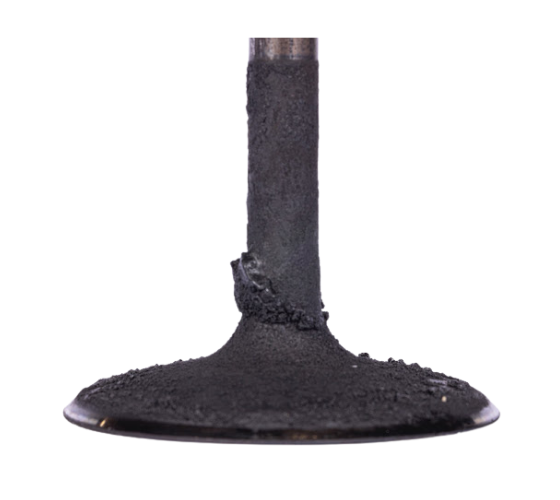Carbon deposits are inevitable, and many automotive professionals don’t take them seriously because they consider carbon to just be a part of engine operation. But when left untreated, carbon buildup can cost vehicle owners more at the pump, and it can lead to expensive and labor-intensive repairs. That’s what we want to help you avoid!
For those that like to “cut to the chase” on how to best minimize carbon buildup, O’Brien Tire & Auto Care recommends that you:
- Be sure you are changing your oil every 3,000 miles for conventional or semi-synthetic vehicles; or 5,000 miles for synthetic oil changes; and
- Cleaning additives or treatments such as BG fuel induction service or MOA/EPR (a “shampoo and conditioner” additive) help with keeping the moving components in the best condition long term.

If you like all that “techy” stuff, read on for the scientific reason why carbon deposits are not good for your vehicle.
What are carbon deposits?
The carbon deposit in an internal combustion engine is a harmful substance that forms on inside surfaces like an engine crankcase, pistons and piston rings, intake and intake valves, as well as internally and externally on fuel injectors. The substance is formed when oil, oil vapor, and fuel react with hot surface temperatures, extreme pressures, and oxidation-- all of which are ever-present in internal combustion engines.
The science: The formation process can be generalized as the polymerization of carbon molecules into long-chain structures deposited on the surface of an engine component.
In reality, these deposits reduce the efficiency of your engine and can mechanically hinder the engine components.
Aren’t modern engines more efficient?
To explain why carbon deposits form in modern engines, here are some facts about the modern internal combustion engine power plant (engine and transmission together).
First, when is an internal combustion engine the most fuel efficient?
In this case, I’m not talking about miles per gallon. I am talking about power (torque) produced by a given air-fuel mixture under a specific engine load and engine speed. This is called brake specific fuel consumption (BSFC).
Simply put, the internal combustion engine is more efficient at low engine speed and high load situations. While the BSFC will be slightly different for every engine, generally speaking, the above statement is true.
What about new fuel efficient engine technologies?
Next, looking at modern power plants inside vehicles today, we see gasoline direct injection (GDI), smaller, downsized, turbocharged engines. Gasoline direct injection offers more control of when and how much fuel is sprayed, which means it can produce maximum torque to do the work necessary to move the vehicle down the road.
Additionally, 8 and 10-speed transmissions squeeze every bit of power out of the smallest amount of engine displacement as possible by balancing a low engine speed and high engine load. All of these technologies are great at keeping the engine operating close to, or within its brake specific fuel consumption sweet spot (most fuel efficient range).
The same holds true for combustion engines in hybrid electric vehicles. In fact, the on-off cycling of HEV gasoline engines creates the ideal environment for deposits to form and heat-soak, building on internal surfaces.
Why do carbon deposits form in modern engines?
As mentioned above, when an engine operates near its most efficient BSFC, it is under a very high load. When engines are under high load, they operate at much higher temperatures. Under this condition for an extended period, the engine and engine compartment become saturated with heat.
We know from defining a carbon deposit that it is produced mainly from the interaction of heat. When we put all of the pieces together, it makes sense that carbon deposits form in modern engines.
- They operate more efficiently under heavy loads.
- Therefore, they produce more heat during operation.
- The heat interacts with unburned fuel vapor, evaporated engine oil, and engine oil itself to form carbon deposits.
To further complicate the issue of carbon deposits, the engine oil used in modern engines also contributes to the problem. Many manufacturers have adopted low viscosity (ie. thinner) engine oils to promote engine efficiency (the thinner the oil the less drag on the engine).
While lower viscosity oils make the engine more efficient, they break down and evaporate much quicker. This evaporated oil deposits itself inside all parts of the engine. In many instances, these deposits can develop very quickly.
How to address carbon deposits in your engine?
- Keep changing oil at OEM recommended intervals. But remember, many vehicle owners are operating their vehicles under what should be considered extreme conditions. In these cases, extended oil change intervals are too long.
- Use a high-quality full synthetic oil and an oil additive to reduce oil oxidation and limit the number of deposits from that source.
- Keeping up with maintenance program. There are methods of cleaning carbon from the induction system, fuel injectors, and combustion chambers that incorporate special tools and fluids specifically formulated to dissolve carbon deposits so they can be expelled from the engine.
By Thomas Probus, BG Automotive Research Specialist